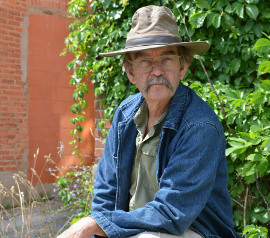 Robert Burcher has worn many hats over the years as a photographer, amateur botanist, researcher, advocate, and writer. These days, more often than not he wears his iconic wide-brimmed hat as he searches for the route that John Muir might have walked as he journeyed from Wisconsin into Canada, where he took up residence in Meaford’s Trout Hollow for two years, from 1864 to 1866.
Robert Burcher has worn many hats over the years as a photographer, amateur botanist, researcher, advocate, and writer. These days, more often than not he wears his iconic wide-brimmed hat as he searches for the route that John Muir might have walked as he journeyed from Wisconsin into Canada, where he took up residence in Meaford’s Trout Hollow for two years, from 1864 to 1866.
John Muir was born in Scotland in 1838. He and his family immigrated to the United States when John was 11 years old. History suggests that John’s brother Daniel travelled into Canada to avoid conscription into the American Civil War and that John followed his brother. In time, John returned to the States, where his passion for the wilderness and his concerns for human encroachment on the environment – in particular logging, mining, and sheep and cattle grazing practices of the day – led him to lobby for an American national park system and in his later years, to form the Sierra Club.
How Muir reached Meaford has been the matter of much speculation. The argument has been made that Muir travelled through Sault Ste Marie. Burcher is of a different mind and he is making it his personal quest to retrace what he believes was Muir’s route from his family’s farm in Wisconsin to Meaford’s Trout Hollow.
“Muir arrived in Meaford to join his bother Danny in the fall of 1864,” Burcher said. “Earlier that year, in May or June, Muir noted in his journal that he had found a calypso orchid in the Bradford area, now the Holland Marsh. The calypso orchid is a rare specimen the size of my thumbnail. He talked about the calypso orchid as one of the three most important findings in his life.
“Muir was a disciplined man from both his religious background and his three years of university studies. He walked miles carrying a satchel, a plant press, and his journals. He made drawings of his findings. He sent his journals home to Wisconsin to family and friends.”
Based on two significant records of Muir’s botanical findings – one by author Bonnie Gisel and illustrator Stephen Joseph, with 115 listings with common names, Latin names, habitat, and the date of the findings, as well as an abbreviated list of more than 200 findings during Muir’s sojourn in Canada published by the John Muir National Historical Site in Martinez, California – Burcher is convinced that Muir walked northward through southern Ontario, likely along the east edge of the Niagara Escarpment.
For the past few years, Burcher has travelled these areas, asking himself: “Okay, if Muir travelled this way what would he have found? Muir wrote in his biography about meeting fellow Scotsmen along the way and finding the calypso orchid in the Bradford area. There are places in the Forks of the Credit area where Muir would have seen the Niagara Escarpment and the Oak Ridge Moraine off in the distance. Archival records show that there were roads open at the time, running east from the Tottenham area west toward the Grand Valley and mills operated by Scottish settlers throughout the present day Adjala and Mono Townships.”
Guided by Muir’s journal entries, his biographies, a growing sense of the man, and some understanding of what would have drawn his attention, Burcher is convinced he is on the right track. “To quote Stephen Leacock, ‘The harder I work the luckier I get,’” he said.
Editor’s note: Robert Burcher will lead a trek into Trout Hollow to the sight of John Muir’s cabin on August 11 during the Trout Family reunion. The hike starts at 10:30 a.m. from the Riverside Community Centre. See the ad in this issue.
Photo: Robert Burcher is on a quest to find the route American conservationist John Muir might have walked while travelling from Wisconsin into Canada to take up residence in Meaford’s Trout Hollow 1864-66.











